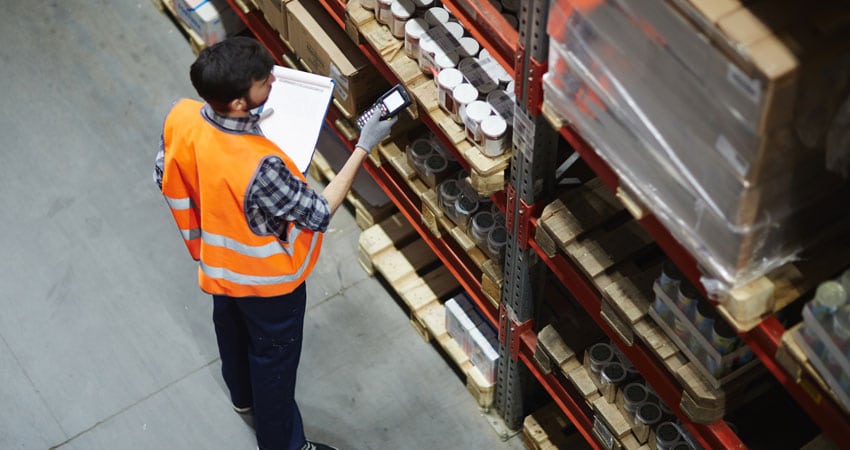It’s often joked that robots will soon replace humans, down to the most menial, everyday tasks. We’ve seen plenty of sci-fi shows and movies, starting with “The Twilight Zone” and Rosie the maid from “The Jetsons.” However, many robotics companies are in an actual arms race to replace human labor, particularly within the supply chain.
However, when the numbers are crunched, it’s often still too costly to implement, leaving humans as the most efficient and effective for warehouse picking.
Warehouse Picking Today
Industry reports estimate that warehouse picking constitutes up to 55% of a fulfillment center’s operating costs. Since warehouse picking directly impacts customer satisfaction, business reputation and profitability, improving this activity is a top priority. The amount of time that associates spend walking from location to location accounts for about 50% of total pick time.
Additionally, finding and retaining staff in today’s tight labor market is difficult. It’s often a repetitive, expensive cycle of hiring and training, only to have them call in sick, fail to show up or quit in weeks or even days.
This means facility managers and business owners must be careful when choosing a picking strategy, which can make or break efficiency. Facility size, availability of financial and human resources, the number of SKUs in stock and quantity/frequency of demand are some of the factors that influence it.
Robotics Seem like the Answer
It would be hard to look at this situation and not see an opportunity for robotics to lighten the load. With technology only being further refined, it might even seem plausible. The logical evolution of robotic picking is a system capable of fine manipulation, picking individual pieces from a bin with an arm and a gripper. Robotic engineers consider fine manipulation to be the next big breakthrough, with the goal of using machine vision and AI to open a jar of peanut butter or pick up a wine glass without breaking it seemingly within reach.
Robots capable of fine manipulation as pickers would, in theory, result in a fully autonomous system that can correctly pick and pack a wide variety of items, regardless of shape, size, weight or packaging design. But that’s where things get exponentially complicated –– and expensive.
It’s Still Not a Feasible Solution
Here’s why robotics for warehouse picking is more complicated than you’d expect, and it has to do with science. There’s a well-known paradox in the field of AI and robotics that refers to the discovery, contrary to what you’d expect, that high-level reasoning requires relatively little computational power, while low-level, sensorimotor skills require an enormous amount of computational power. In other words, what’s typically difficult for a person — like winning a game of chess — is easy for a machine. And what’s easy for a person — picking a pen out of a drawer full of pencils — is quite complicated for a machine.
While a handful of companies are working on piece-picking systems that have demonstrated a measure of success in picking individual items out of totes, there are still numerous issues in deploying such systems at scale. One is the fact that most robotic arm systems are stationary. In order to pick items for orders, totes need to be brought by shuttle, conveyor or by other robots. This almost certainly requires a warehouse redesign or construction of a new facility –– a huge undertaking in time and cost.
Another issue is that the current generation of robotic arms at work in factories perform specialized tasks with grippers designed to grasp specific objects. Designing a gripper that can mimic the sensitivity and versatility of a human hand requires immense computational power, so most robotic picking arms use suction grip items, which often limits what they can lift.
Consider the items you can order online: A box of laundry detergent, a jar of pickles and a bag of rice. You could pick any of these items off a shelf easily with one hand despite the variations in size, shape and weight. But for a robotic arm, it would not all be accessible equally. The box of detergent is a heavy cube, while the pickles are in a glass cylinder, and the rice is in a flexible sack. Developing an arm with a vision system and a gripper that could properly identify and pick up each of those items (and thousands of others) correctly every time would be prohibitively expensive to build, to buy, and to maintain.
Current Solutions That Make Sense
Although robotics doesn’t seem to be the answer in the foreseeable future, there are better solutions. Minimizing the number of hands that SKUs pass through before shipping is a great way to boost productivity and efficiency. Companies should invest in hands-free equipment and technologies that promote warehouse automation. Although this comes with upfront costs, the ROI is worth the initial investment.
Employing a combination of human workers for picking in tandem with automation like autonomous mobile robots (AMRs) that work with them is really the best bet. In the current labor shortage, taking advantage of wearable technology and labor analytics to help coordinate both humans and machines creates a solution that is more palatable for most organizations as a path to automation. Plus, many current wearable technology options offer voice picking and communication with modern warehouse automation and execution systems, which can help streamline the picking process as well.
Unfortunately, or fortunately depending on how you look at it, a future where robots replace humans in the supply chain is a lot further away than we think. Thankfully, there are several accessible, high-tech solutions to upgrade the warehouse picking experience.
Gabe Grifoni is founder and CEO of Rufus Labs

